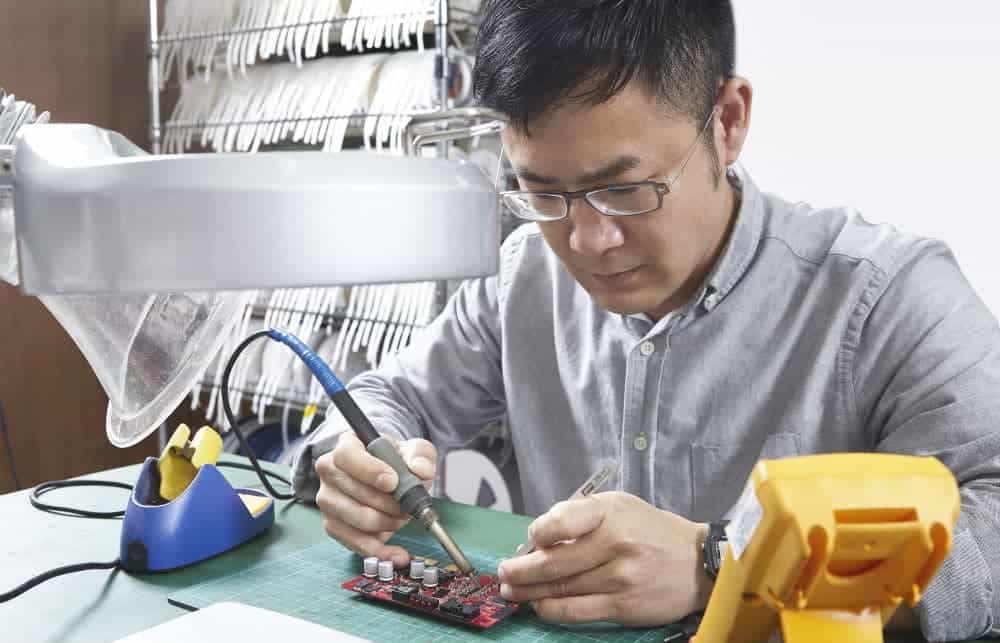Electronics Prototyping Services
In electronics, prototyping is a vital stage and actual device that works as a way to test market hypotheses and decide whether to move along with product development or not.
Prototypes are a critical step in our electronic product development process. We help the B2B companies we work with their electronic prototype design and development in several rounds of increasing accuracy.
Proof of Concept (PoC)
A rudimentary, out-of-form-factor electronics prototype can be made during the early stages of development to serve as a Proof of Concept.
Using off the shelf development boards such as Arduino, Raspbery Pi, or the STM32 Blue Pill a good engineer can often quickly whip up electronic prototypes which tend to look rather “Frankenstein”.
But the importance is that it works and can demo the system. Especially in IoT projects these kinds of POC electronic prototypes are often used to test the concept with the target users.
Partial electronic prototypes
After confirming with a POC that the functionality is indeed what customers want, we then need to validate that we can go from electronic prototyping to mass production in volume at an acceptable cost.
For this, we make partial functional electronic prototyping, to make sure we can meet a product’s Key Technological Challenges.
Leavings the hardest parts till the end only wastes everybody’s time and money. A big part of the go/no go decision is cost: can the required performance be delivered within the target unit cost?
Electronic Prototyping with Key Electronic Components from Asia for a Go / No Go.
We often build partial electronic prototypes to test the cost/performance/reliability of various candidate key components, such as a camera module.
Our intimate knowledge of the component eco-system in China & Taiwan is key, affordable quality components often make or break the business case for nearly all new electronic products.
Relying solely only on the components which can readily be found on internet sites such as digikey.com has killed many a business case.
Electronic prototype – Mock-up
To evaluate different options on the industrial design side we often start with simple foam block mock-up to evaluate hand-held ergonomics, balance, and size.
Of course, as soon as we have something in 3D CAD we will make 3D printed prototypes. Doing these in-house allows us to iterate very fast.
Looks-like-works-like electronics prototyping
For reasons of speed and IP protection, we do all our electronics prototyping in-house.
The PCB’s are often hand soldered by our nifty technicians, for housings we initially use 3D printing, or we make our own cast molds to simulate silicone parts such as wrist bands and suction cups.
For presentation models, we use external CNC’ed parts, which can be cut out the exact target plastic material. Our design engineers assemble the working electronics prototypes themselves to assure proper functionality.
Electronics Prototype testing is key
As soon as we have some level of working electronic prototype we start working on the full range of tests as defined in the Requirements Traceability Matrix. This is basically an excel sheet where every single specification has a test to pass.
We send a number of electronic prototypes to our clients for field-testing, to get real user feedback to identify usage and reliability issues and gather suggestions for improvements.
Pilot run units/pre-production samples
After sufficiently testing the electronic prototypes, we make pre-production electronic prototypes or pilot units.
3D printed or CNC’ed housings tend to be brittle and break easily, so the only injection molded parts will give you an accurate representation to do drop-test and ingression tests of water & dust.
These preproduction units are assembled from injection-molded parts and PCB Assemblies produced by an automated SMT line.
Minimal Viable Product (MVP)
A Minimum Viable Product has the minimum set of core features to make it saleable to early adopters.
The idea is that user feedback is so essential for the viability of a new Business Unit or startup, that you need to get the first generation to market as quickly as possible.
On a grand scale, an MVP could be seen as a form of electronics prototyping, in that you are clearly planning to launch a Generation 2 after you have received market feedback on Generation 1.
MVP is a well-known term in software development, but you have to realize that for an electronic MVP it is not nearly as easy to solve bugs, once a unit has been sold.
So even if the feature set is limited, you do need to do a full product development process.
One way to reduce the RMA‘s is to only manufacture a limited number, and reduce NRE investment by using soft molds. It is a very valid approach because every first-generation electronic tends to bring failure modes that no one had expected.
The importance of an Electronic prototype
An electronic prototype is the product of the electronic development process and is an essential part of the design, development, as well as certification procedure.
In electronics prototyping, we take a concept that exists only on paper and substantiate it into a physical form that functions as the envisioned product should.
How an electronic product will respond to user input is difficult to evaluate without experiencing it first-hand.
As a tool in the development process used to validate the electronic design, a prototype is crucial for understanding the complex interaction between user and device.
What it takes to create a perfect golden sample
During the development stage, several working electronic prototypes may be produced, usually by hand, and are tested by our engineers.
The electronic prototypes are then sent to our client for further testing in the field to gather feedback and to identify bugs that will later be corrected.
Once an electronic prototype has undergone sufficient testing and validation, a pre-production prototype is then marked as the “golden sample”.
This is then used as the benchmark or standard to which mass-produced units will be compared. This golden sample is also used for certification purposes and sent to a third-party testing facility for CE, UL, FCC, or ROHS markings.
We work on prototypes as part of the full product development process. If you’re looking for manufacturers that make prototypes as a standalone service or China prototype manufacturers only, then we might not be the best fit for you, but we can still hook you up with the right people; just get in touch with us.



